Victory in Europe 2 – Liberation & Aftermath
by Glenn Warner
Maple Leaf Up presents the following photo essays:
Intro – Victory in Europe.
Story 1 – Dutch Privation & German Capitulation in Holland.
Story 2 – this page – Liberation of The Netherlands and the Aftermath of War.
Story 3 – VE Day on the Home Front in Canada.
*****
Liberation and its Aftermath
And so it was over. At least in The Netherlands and Northern Germany. In Wageningen, after agreeing to the terms of German surrender on May 5th, German General Blaskowitz asked for and received a day’s reprieve from Canadian General Foulkes to inform German soldiers in Fortress Holland of the unconditional surrender. The last signing formalities between these generals took place in the auditorium of the agriculture college, beside the Hotel De Wereld, on 6 May 1945 at 5pm.
Then 1st Canadian Corps was on the move again, now into the more populated Dutch provinces, including North Holland, South Holland, and Utrecht. And after five years of tyranny, almost to the day, the euphoric Dutch crowds came out to greet them at every town along the maple leaf route.
In Northern Germany, 2nd Canadian Corps had to make their presence known amongst the defeated German troops. Sherbrooke Fusilier tank commander Major Radley-Walters was told to take 40 Sherman tanks and make a show of force through Emden, Aurich and Wilhelmshaven, Germany.
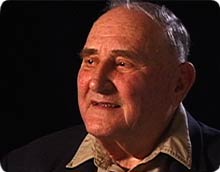 Major Sydney Radley-Walters: “I got into my scout car and got all the tanks from A, B, and C Squadron together and we rolled through Emden with the swastika tied to the back and dragging in the mud. We went right through and of course Emden and Wilhelmshaven all the naval people were still there, the marines were still there, infantry battalions were there and everybody was still armed."
Major Sydney Radley-Walters: “I got into my scout car and got all the tanks from A, B, and C Squadron together and we rolled through Emden with the swastika tied to the back and dragging in the mud. We went right through and of course Emden and Wilhelmshaven all the naval people were still there, the marines were still there, infantry battalions were there and everybody was still armed."
It was May 7th, 1945. The Netherlands was now liberated. And Germany was now occupied.
*****
Monday, 7 May 1945 - Netherlands and 1st Corps
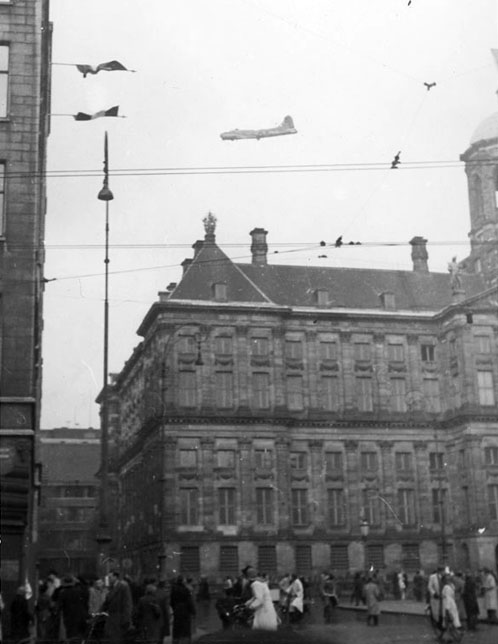
"Maandag, 7 Mei" — Dutch photographer Kryn Taconis no longer has to conceal his camera from the Germans after liberation. The B17 Flying Fortress to the west is most likely laden with racks of food supplies as opposed to racks of bombs. The building in the centre with the dome on the upper right is the south wing of the Koninklijk Paleis (Royal Palace) in Dam Square, Amsterdam. Kryn Taconis would have taken this shot from the corner of Rokin and Paleisstraat (Palace Street). The building on the immediate left edge of the photo is now Madame Tussaud's. Monday, 7 May 1945. (See current View on Google Maps.) (Photographer: Kryn Taconis; Library and Archives Canada e002283035)
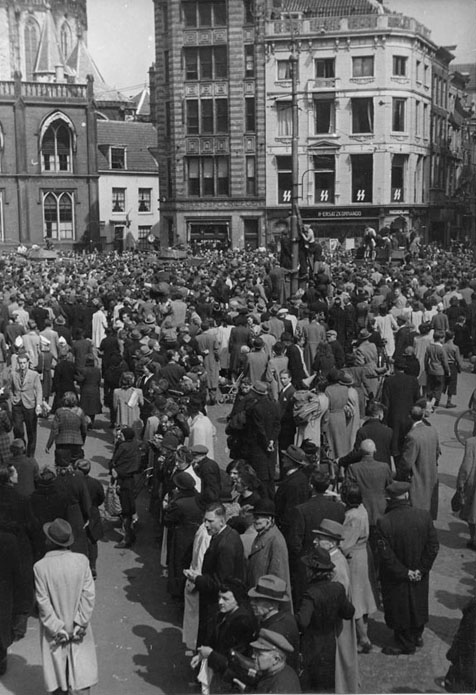
"Maandag, 7 Mei" — Another shot by Dutch photographer Kryn Taconis. Crowds gather in Dam Square, Amsterdam, awaiting the Canadians and celebrating their liberation. Food relief is in sight. The building on the upper left is the 17th Century Nieuwe Kerk (New Church), just next to the Royal Palace (see photo above). Note the German SS office in the white building on the corner of Dam Square and Nieuwendijk (the main shopping street between Dam Square and Central Station). Monday, 7 May 1945. (See current View on Google Maps.) (Photographer: Kryn Taconis; Library and Archives Canada e002283036)

Meanwhile, CFPU photographer Alex Stirton has moved from Wageningen to occupied Utrecht as reconnaissance units of 1st Canadian Army enter the city and jubilant Dutch civilians celebrate their liberation. These soldiers are actually British from the 49th (West Riding) Division — the Polar Bears — who were often attached to 1st Canadian Army (in April as part of 1st Corps). Utrecht, Netherlands, 7 May 1945. (Photographer: Alex Stirton; Library and Archives Canada a134377)
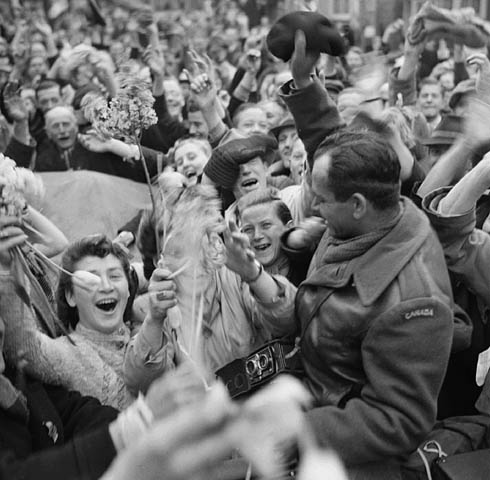
The liberation of Utrecht continues and these Dutch women offer tulips to their liberators. During the famine, tulips were being routinely eaten by the Dutch. The soldier in the foreground, shouldering the Rolleiflex camera, may be part of the Canadian Film and Photo Unit. It may in fact be Alex Stirton himself, who shot on 2-1/4" stills format. Utrecht, Netherlands, 7 May 1945. (Photographer: Alex Stirton; Library and Archives Canada a134376)
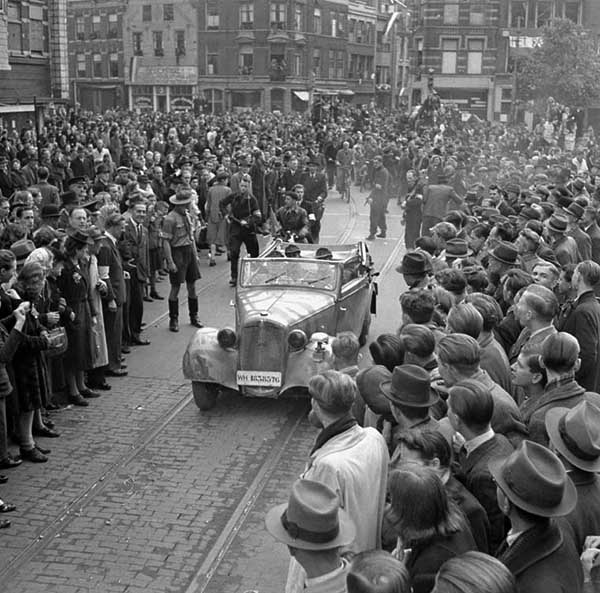
Photographer Stirton has set up a high angle of the liberation crowd in Utrecht. The dark figures behind the vehicle brandishing machine guns are members of the Dutch underground. Are they escorting a German vehicle out of the city? Utrecht, Netherlands, 7 May 1945. (Photographer: Alex Stirton; Library and Archives Canada a134455)
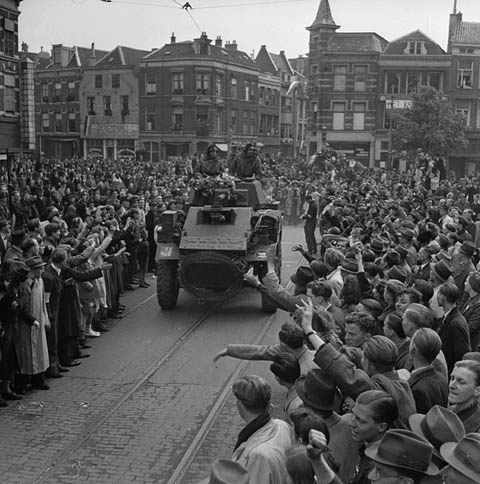
Same angle by Stirton only this time the vehicle is a Humber reconnaissance car of the 49th (West Riding) Division, Canadian 1st Corps. Utrecht, Netherlands, 7 May 1945. (Photographer: Alex Stirton; Library and Archives Canada a133323)
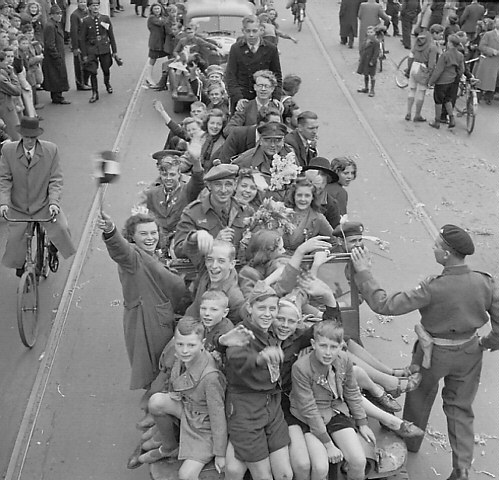
Another high angle by Stirton of soldiers surrounded by Dutch kids. The girl on the left waves the Dutch tricolour. Utrecht, Netherlands, 7 May 1945. (Photographer: Alex Stirton; Library and Archives Canada a140417)
*****
7 May 1945 – Meanwhile in Germany with 2nd Corps
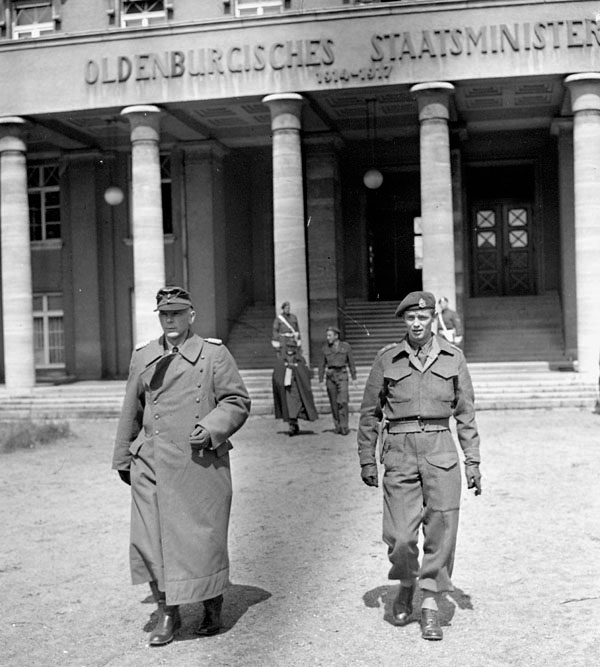
German Major-General Stephan, the commander of Battle Group Stephan in northern Germany, is accompanied by Captain P. Fafard of the 2nd Canadian Infantry Division into a surrender conference, Oldenburg, Germany, Monday, 7 May 1945. (Photographer: Barney J. Gloster; Library and Archives Canada a197988)
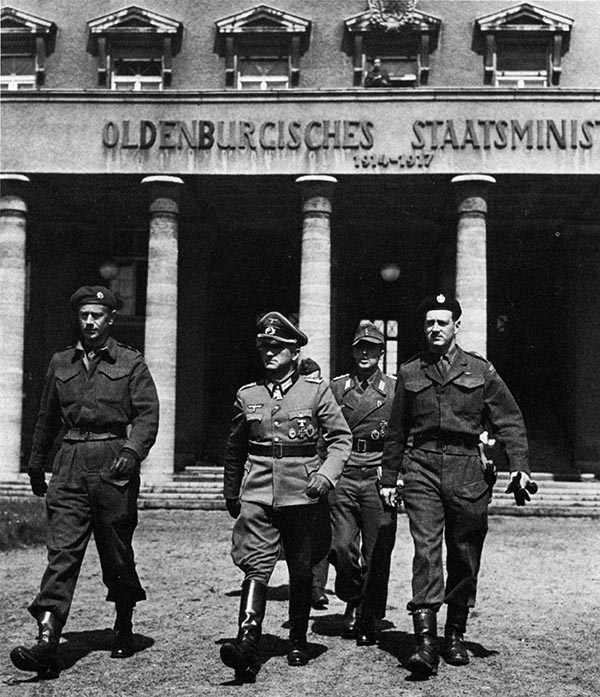
Same angle by CFPU photographer Lt. Barney Gloster. Maj. Gen. Benrend arriving in custody of Lt. W.B. Walker, heading to surrender proceedings. The idea of a defeated Major-General being escorted by a victorious lieutenant is wonderfully derisive. 7 May 1945, Oldenburg, Germany. (Photographer: Barney J. Gloster; Library and Archives Canada a135910)
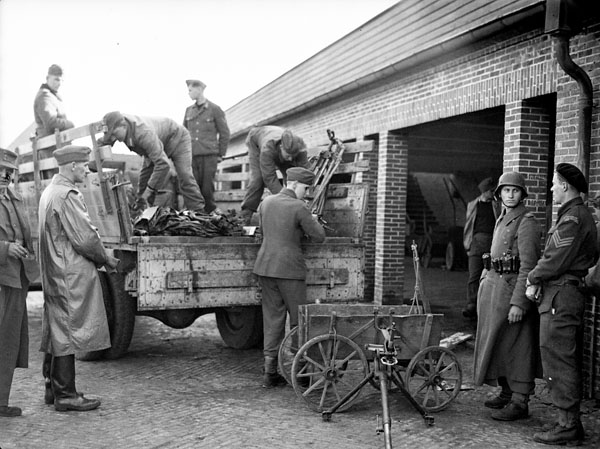
In Aurich, German prisoners of war offload weapons at their military barracks during the disarmament. The Canadian Film & Photography Unit sergeant talking to the German POW at right looks like cinematographer Lew Weekes. Aurich, Germany, 7 May 1945. (Photographer: Donald Grant; Library and Archives Canada a208362 )
*****
1945 – Defeat & Victory
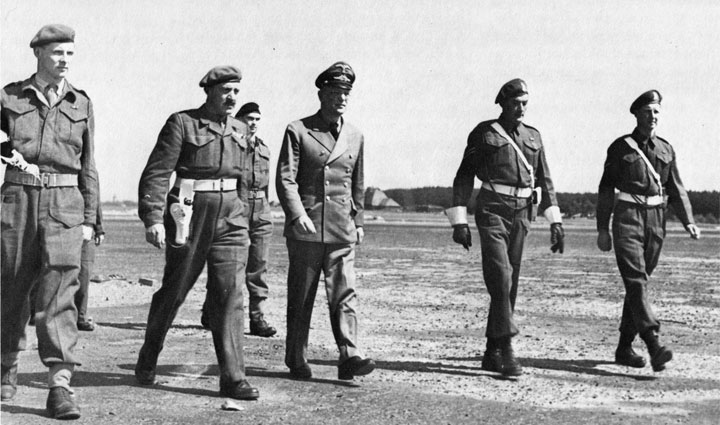
8 May 1945. Arthur Seyss-Inquart, Reichskommisar of the Netherlands, (centre of photograph) was placed under arrest by Canadian officers and escorted from the airport at Hengelo, Netherlands to First Canadian Army headquarters on May 8, 1945. (Photographer: CE Nye; Library and Archives Canada a176571)
Arthur Seyss-Inquart was an Austrian Nazi who was appointed Reichskommisar of German-occupied Netherlands. He was found guilty at the Nuremburg war-crime trials, sentenced to death, and hanged on 16 October 1946, at the age of 54, together with nine other defendants.
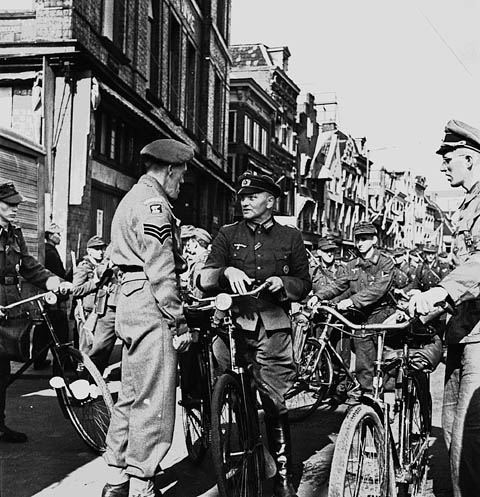
8 May 1945. Back in Utrecht, Netherlands. German officers and troops coming in to surrender and dump their arms. (Photographer: Michael M. Dean; Library and Archives Canada a134388)

9th May 1945. Canadian 1st Corps is still on the move to relieve parts of occupied Netherlands on the west coast not yet reached. Here, infantrymen of the West Nova Scotia Regiment in a Universal Carrier en route to the large port city of Rotterdam are surrounded by Dutch civilians celebrating the liberation of the Netherlands. (Photographer: Barry Gilroy; Library and Archives Canada a134390)

9 May 1945. German soldiers entering a concentration area to be disarmed by soldiers of the 1st Canadian Corps, Breukelen, Netherlands. The sign suggests the 1st Corps soldiers are Brits from the Polar Bears.
This building is the carriage house (Dutch: koetshuis) for Nijenrode Castle (Kasteel Nijenrode) which now houses the Nyenrode Business University, in the town of Breukelen, near Utrecht. (View PopUp of same view.) (Or see current View and map on Google Maps.) To let us know what you think, please Contact Us. (Photographer: Michael M. Dean; Library and Archives Canada a134395)
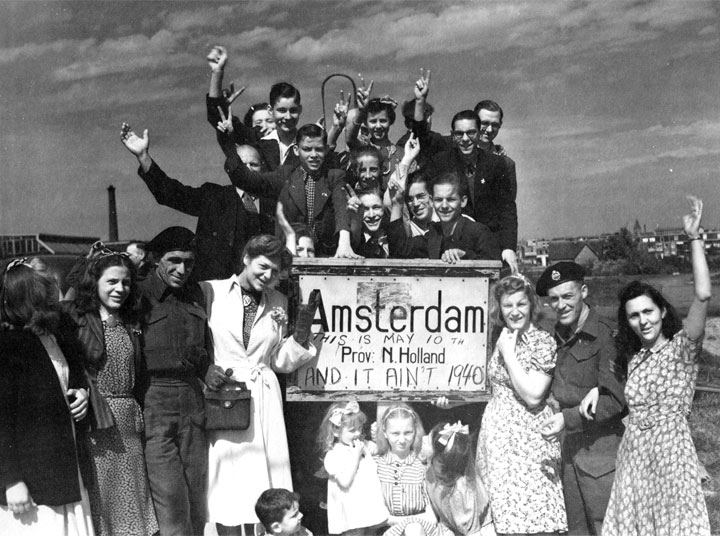
10 May 1945. Recently liberated Dutch civilians and Canadian soldiers pose with a sign in Amsterdam indicating that the city had been liberated after almost five years of occupation. The sign reads: "Amsterdam, North Holland. This is May 10th. And it ain't 1940."
Trooper Frank Grummett (left) and Sergeant Doug Skene (right) of the CFPU (Canadian Film and Photo Unit) pose with the jubilant Amsterdammers. Cinematographer Skene had arrived in North-west Europe in time for final stages of campaign in Holland and Germany. The CFPU usually travelled in teams of three personnel, so most likely this 3-pack includes Grummett the enlisted (trooper) driver, Skene the sergeant cinematographer, and Mickey Dean, taking this photo, as the officer photographer. (Photographer: Michael Dean; Library and Archives Canada a114069)
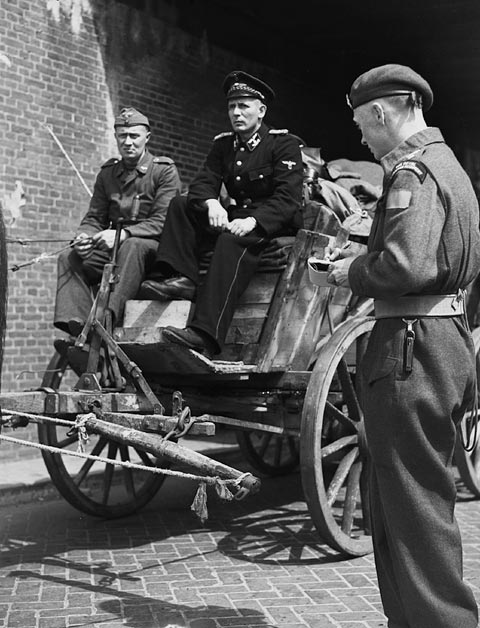
11 May 1945. Captain Aylan Parker checks a German officer's name in the course of disarming of German forces. Ijmeuden, Netherlands. (Photographer: Alex Stirton; Library and Archives Canada a129748)
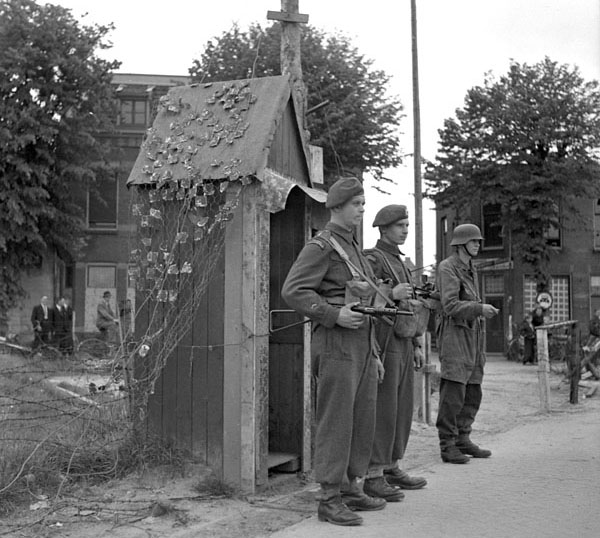
11 May 1945. Privates W.R. Hill and M.A. Gammon of 1st Canadian Corps on guard duty with a German soldier, also on guard duty, at the German prisoner of war garrison, Ijmuiden, Netherlands. (Photographer: Alex Stirton; Library and Archives Canada a134397)
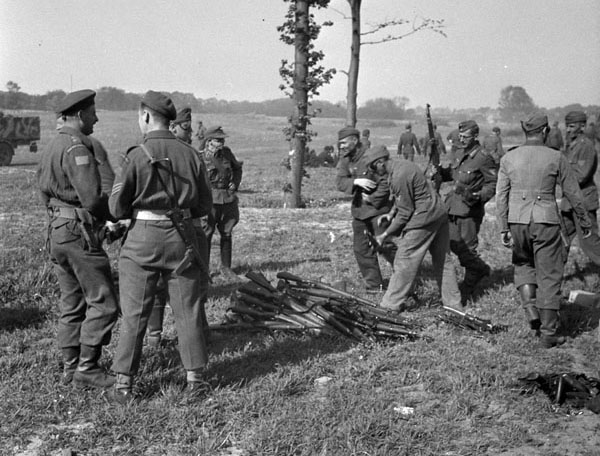
13 May 1945. German soldiers handing in weapons at a 1st Canadian Infantry Division arms dump, Rotterdam, Netherlands. (Photographer: Barry Gilroy; Library and Archives Canada a134425)
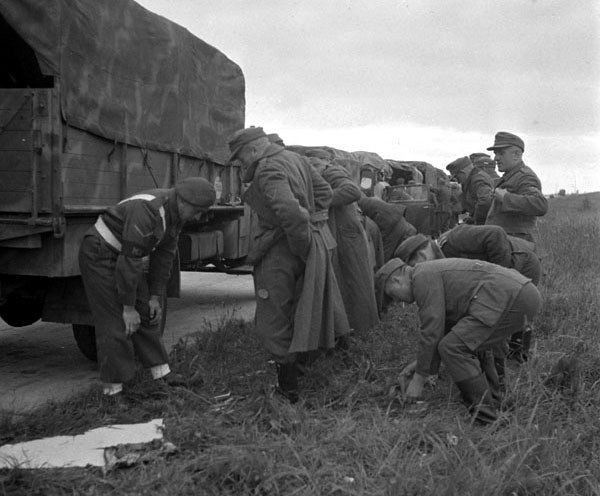
27 May 1945. Lance-corporal J.G. Kallenberger searching a group of German prisoners before their return to occupied Germany. Den Helder, The Netherlands.
(Photographer: Ken Bell; Library and Archives Canada a135996)
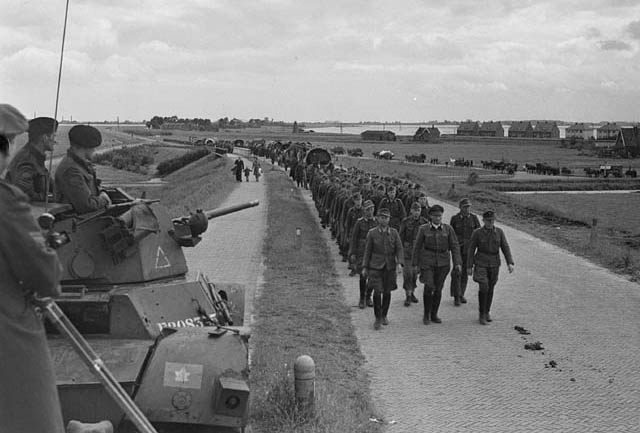
28 May 1945. Columns of disarmed German soldiers en route to occupied Germany. Canadian 1st Corps troops watch from the Dutch bicycle path. Near Amsterdam, Netherlands. (Photographer: Donald Grant; Library and Archives Canada a134287)

14 June 1945. Private Howard Heath guards the recently-arrested General Johannes Blaskowitz at 1st Canadian Army Headquarters, Apeldoorn, Netherlands. Blaskowitz was the General Officer Commanding German forces in The Netherlands who surrendered to Canadian 1st Corps General Foulkes. Blaskowitz was later charged with war crimes at the Nuremberg Trials. But before his trial was concluded he escaped his own possible execution. In February 1948 he committed suicide by throwing himself off a balcony in Nuremberg. (Photographer:Barney J. Gloster; Library and Archives Canada a138038)
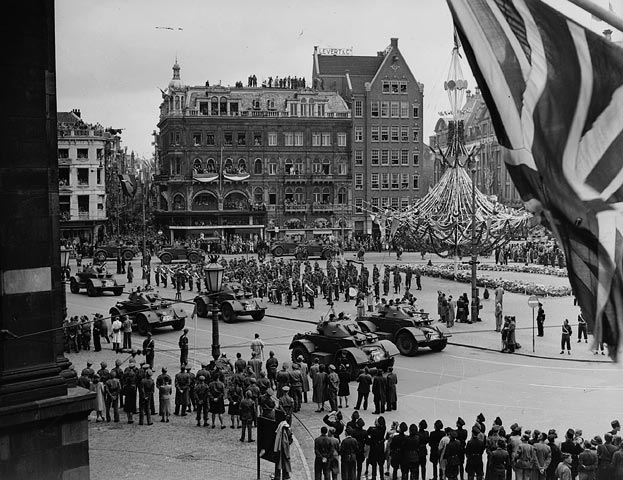
28 June 1945. A parade in Dam Square, Amsterdam celebrates the return of Queen Wilhelmina to the Netherlands. This photo, taken by Canadian Film & Photo Unit photographer Lt. Barney Gloster, is probably taken from the Grote Club at #1 Paleisstraat (Palace Street) from where German soldiers fired on the jubilant liberation crowd on 7 May. Directly across Dam Square in the centre of the photo is #2 de Dam, which was a Nazi recruiting centre. It is now the ABN AMRO Building. The foreground building with the white brick at extreme left of frame is the Royal Palace. Queen Wilhelmina had spent the war in England. In three years the queen would abdicate in favour of her eldest daughter Princess Juliana, who spent the war in Ottawa, Canada. (Photographer: Barney J. Gloster; Library and Archives Canada a166390)
*****
After War, Love
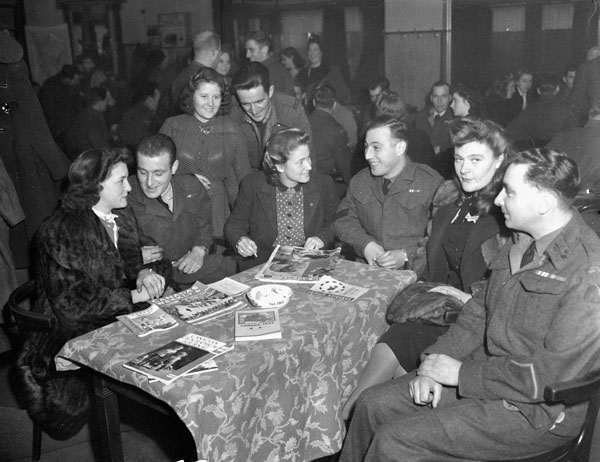
16 November 1945. Though the victory came in May 1945, some of the young Canadian soldiers would live in The Netherlands well in to 1946 before becoming eligible to come home to Canada. Here, personnel of 4th Canadian Armoured Division and their Dutch fiancées. (L-R): Gnr. W.G. Dobbin & Wilhelmina De Groot, Gnr. R.A. Jennings & Rita Nies, Cpl. E.P. Weiss & Nancy Raven, Pte. N. Landry & Aaltaga Berends. Amersfoort, Netherlands. (Photographer: Ken Bell; Library and Archives Canada a140422)
The Photo Essay on Victory in Europe continues next page. ![]()
*****
If you have any observations, comments, insights, or see any errata, typos, or anything nutty when viewing these photos, please contact us. (Refer to photo reference numbers if possible.)







